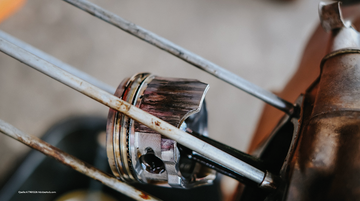
Only if you install a piston safely and correctly will you get its full quality and reliability. In this blog you will learn tips and tricks on how to successfully install the piston. And at the same time you will expand your knowledge about pistons. If you have any further questions, please feel free to contact us. You can find our contact details at the end of the article.
Determination of piston diameter
First of all, you determine the piston diameter. The nominal size of the piston is measured at room temperature on the piston skirt, 90° and approx. 10mm above the lower edge. The installation clearance should be determined as follows depending on the cylinder material, cooling and performance range:
Aluminum cylinder: 0.6 – 1.4‰ of the nominal diameter
Cast iron cylinder: 1.2 – 2.0‰ of the nominal diameter
Here's an example:
The measured cylinder diameter is 39.00mm
The installation clearance at 1‰ is then: 39mm*0.001 = 0.039mm
Result: A piston with a diameter of 38.96mm must be used.
Note: Piston coatings such as the Blue Sapphire coating have a thickness of approx. 10-20μm and are not taken into account for the installation clearance. If the installation clearance is too high, running noise and wear increase. If the clearance is too small, cold welding can occur between the piston and the raceway. It is therefore important to determine the installation clearance as accurately as possible.
Ring push game
The next step is to calculate the ring kick game. This can be determined by installing the piston ring without a piston in the cylinder. Note: The piston ring must be orthogonal to the raceway otherwise incorrect measurements can occur.
The ring kick game can now be spied out using a feeler gauge. It should be at least 4‰ from the nominal diameter.
Here is an example:
The nominal diameter is: 39.00mm
The ring joint clearance at 4‰ would be: 39mm * 0.004 = 0.156mm
If the clearance is too small, stresses will arise in the ring due to thermal expansion. The piston rings are pressed against the raceway with increased pressure. Wear increases and the piston ring can break. If the clearance is selected too high, the compression is minimized. So, here too it is very important to carry out the measurement as precisely as possible so that there is no undesirable loss of quality.
Installation direction of the piston
The direction of installation of the piston is indicated by an arrow on the piston crown. The arrow must point in the direction of the cylinder exhaust.
Assembly preparation
Please check your delivered components for completeness and condition. Make sure to keep the components and your assembly environment clean. Always coat pistons, rings, piston pins and cylinder liners with a light film of oil when assembling them. This increases the service life of the parts.
Do not drive in the piston pin; if it is difficult to move, warm the piston slightly.
You can find important information about the piston ring in our blog post “ How to – Piston Rings ”.
When installing the piston clips, please note:
Piston clips must not be pressed together to insert them into the recess! By squeezing, the pre-tension can be reduced. This makes it easier for the clips to fall out or holds harder in the groove. Therefore: first place one end of the clip in the groove. Then place the clip into the puncture in a spiral movement. The openings and noses of the clips must point in the direction of travel of the piston. Otherwise the clips will start to flutter at high accelerations and can break.
We strongly recommend always using new clips. You can also find them in our online shop in the usual BARIKIT quality.
Everything should be clear now, right? If you have any questions or need help with installation, please contact us! We are glad to help you.
Did you like the blog post? Feel free to tell us by leaving us a comment.
You would also be doing us a big favor if you left us a Google review or product review. This helps us to make other moped enthusiasts aware of our BARIKIT parts.
